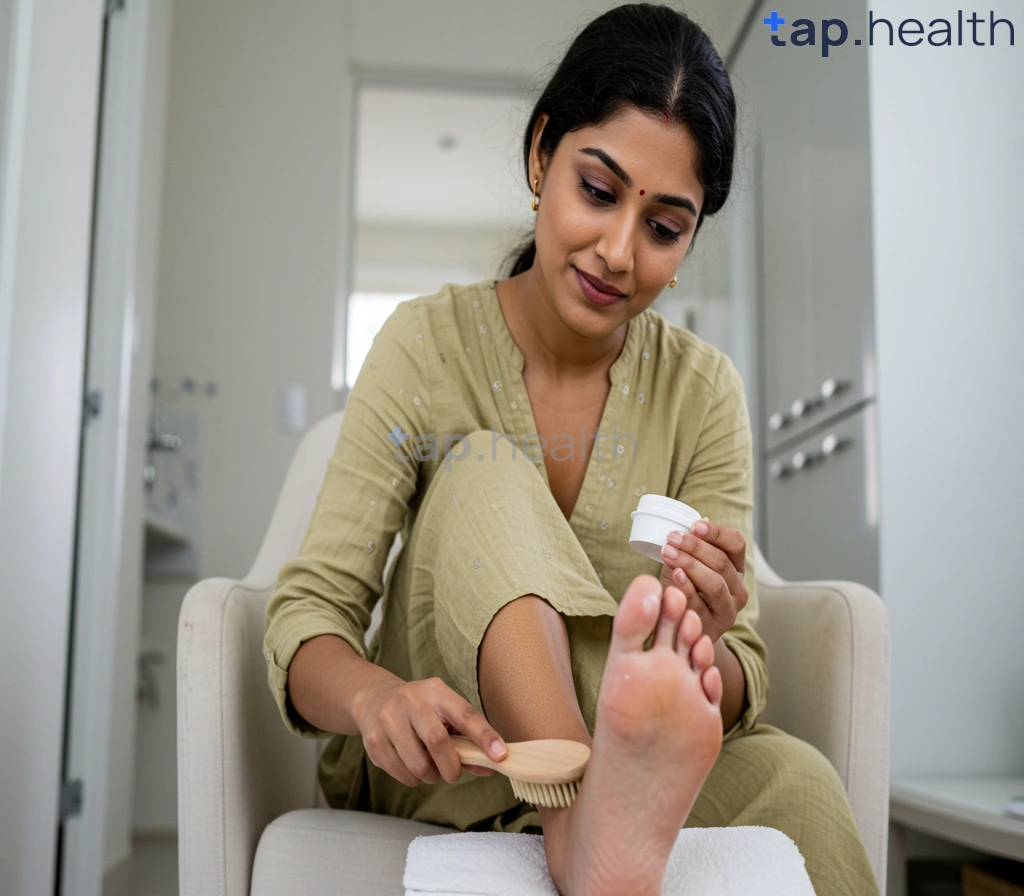Table of Contents
- 5-Minute Diabetic Foot Care: A Quick Guide
- Diabetic Foot Care: 5 Steps to Healthy Feet
- Check Your Feet Daily: 5-Minute Diabetic Routine
- Prevent Foot Problems: 5-Minute Diabetic Check
- 5 Simple Steps for Healthy Diabetic Feet
- Frequently Asked Questions
- References
Living with diabetes means taking extra care of your body, and that includes your feet! Diabetic foot care is crucial for preventing serious complications, and it doesn’t have to be a time-consuming chore. In this post, we’ll guide you through 5-Minute Diabetic Foot Care: 5 Steps to Healthy Feet – a simple, effective routine you can easily incorporate into your daily life. Learn how these quick checks and simple actions can make a big difference in protecting your foot health and overall well-being. Let’s get started!
5-Minute Diabetic Foot Care: A Quick Guide
Diabetic foot care is crucial, especially in hot and humid climates prevalent in India and other tropical countries. Nearly 15% of diabetics experience foot ulcers in their lifetime, highlighting the critical need for proactive care. These ulcers significantly increase the risk of amputation, a devastating consequence that can be largely prevented with consistent, simple foot care.
Step 1: Daily Inspection
Take a moment each day to visually examine your feet. Look for any cuts, blisters, redness, swelling, or changes in skin color or temperature. Use a mirror to check areas you can’t easily see. Early detection is key to preventing serious complications. In humid climates, pay extra attention to areas prone to sweating and fungal infections.
Step 2: Gentle Washing
Wash your feet daily with lukewarm water and mild soap. Avoid harsh chemicals and hot water, which can dry out your skin and increase the risk of cracking. Gently pat your feet dry, paying particular attention to the areas between your toes. Proper drying prevents fungal growth, a common issue in tropical regions. If you notice cracked heels, you might want to read more about that in our article, Are Cracked Heels a Sign of Diabetes? Foot Care Tips.
Step 3: Moisturizing
Apply a fragrance-free moisturizer to your feet, but avoid applying it between your toes. This helps keep your skin soft and prevents cracking, which can lead to infections. Choose a moisturizer specifically designed for diabetic feet.
Step 4: Nail Care
Trim your toenails straight across and file down any sharp edges. Avoid cutting your toenails too short to prevent ingrown toenails, a common problem that can easily become infected. If you have difficulty trimming your nails, seek professional help from a podiatrist.
Step 5: Comfortable Footwear
Wear clean, comfortable socks made of breathable materials like cotton. Avoid wearing tight shoes or shoes that rub against your feet. Choose well-fitting footwear that provides adequate support and cushioning, especially important in regions where you may be walking on uneven surfaces.
Taking these five simple steps every day can significantly reduce your risk of developing foot problems. Consult your doctor or a podiatrist regularly for professional foot examinations, especially if you’re experiencing any issues. Prioritizing foot care is an investment in your overall health and well-being. For more comprehensive tips, check out our guide: Top 5 Foot Care Tips for Diabetics | Easy Steps to Healthy Feet.
Diabetic Foot Care: 5 Steps to Healthy Feet
Diabetic neuropathy, affecting 30-50% of diabetic patients in India and other tropical countries, significantly impacts foot health. This condition causes pain, numbness, and reduced mobility, increasing the risk of foot ulcers and infections. Protecting your feet is crucial for maintaining your overall well-being. Here’s a simple 5-step routine you can incorporate into your daily life:
1. Daily Visual Inspection
Every day, thoroughly examine your feet. Look for any cuts, blisters, redness, swelling, or changes in skin color or temperature. Even small wounds can become serious infections in people with diabetes. Pay close attention to areas between your toes, often overlooked but prone to dryness and cracking, especially in the hot and humid climate of tropical regions.
2. Gentle Foot Washing
Wash your feet daily with lukewarm water and mild soap. Avoid soaking your feet, as this can dry out the skin, making it more susceptible to cracking. Pat your feet dry gently, especially between the toes, using a soft towel. Remember to moisturize your feet after washing, but avoid applying cream between your toes.
3. Proper Footwear
Wear comfortable, well-fitting shoes made of breathable materials like cotton or canvas. Avoid wearing sandals or flip-flops, which offer inadequate protection. Choose shoes with a good arch support, especially important for those experiencing diabetic neuropathy and foot pain. Inspect your shoes daily for any debris that could injure your feet. If you experience Does Diabetes Cause Swollen Feet? Understanding the Connection, proper footwear becomes even more critical.
4. Regular Nail Care
Trim your toenails straight across, avoiding cutting into the corners which can lead to ingrown toenails. If you have difficulty trimming your nails, consult a podiatrist. Maintaining healthy nails is vital for preventing infections. In tropical climates, fungal infections are more common, so keep your feet clean and dry to minimize the risk. Changes in temperature sensitivity, such as experiencing Are Cold Feet a Symptom of Diabetes? , warrant extra attention to foot care.
5. Consult a Healthcare Professional
Regular check-ups with your doctor and podiatrist are essential. They can monitor your foot health, detect early signs of complications, and provide personalized advice. Don’t hesitate to seek immediate medical attention for any foot injury, no matter how minor. Early intervention is key to preventing serious complications. Schedule an appointment today for comprehensive diabetic foot care.
Check Your Feet Daily: 5-Minute Diabetic Routine
Diabetes can significantly impact your foot health, increasing the risk of infections, nerve damage (neuropathy), and poor circulation. Regular foot care is crucial, especially in hot and humid climates prevalent in India and other tropical countries where fungal infections are more common. This 5-minute routine will help you maintain healthy feet.
Step 1: Visual Inspection
Take a moment to carefully examine your feet daily. Look for any cuts, blisters, redness, swelling, or changes in skin color or temperature. Pay close attention to areas between your toes, where moisture can easily build up, leading to infections. Early detection is key to preventing serious complications.
Step 2: Gentle Washing
Wash your feet daily with lukewarm water and mild soap. Avoid very hot water, which can dry out your skin and exacerbate existing problems. Pat your feet dry thoroughly, especially between your toes. Consider using a moisturizer specifically designed for diabetic feet to combat dryness, a common issue in tropical environments.
Step 3: Nail Care
Trim your toenails straight across, avoiding cutting into the corners, which can lead to ingrown toenails. Use a nail file to smooth any rough edges. Never attempt to remove calluses or corns yourself; consult a podiatrist for professional care.
Step 4: Moisturize
Apply a suitable moisturizer to your feet, avoiding the area between your toes. This is especially important in hot and humid climates where the skin tends to dry out more quickly. Choose a fragrance-free, non-comedogenic lotion to minimize the risk of irritation.
Step 5: Regular Check-ups
Schedule regular check-ups with your doctor and a podiatrist. They can monitor your foot health, assess for any complications, and provide tailored advice. Maintaining a healthy diet, including managing carbohydrate intake (generally 45–60 grams per meal is suggested for most people with diabetes, though individual needs vary), is also crucial for overall health and foot well-being. Remember, proactive foot care is your best defense against serious diabetic foot complications. For more tips on managing your diabetes effectively, check out our guide: 10 Proven Tips to Effectively Manage Diabetes | Simple Guide.
Consult a healthcare professional for personalized advice on managing your diabetes and foot care. Regular foot checks are essential for preventing complications and maintaining healthy feet, especially in the Indian and tropical climate. Since diabetes can affect multiple systems, it’s also important to focus on heart health. Learn more about protecting your heart with our article: Protect Your Heart from Diabetes: 5 Essential Steps
Prevent Foot Problems: 5-Minute Diabetic Check
Why Regular Foot Checks Are Crucial
Diabetes significantly increases the risk of foot problems. A recent study in India revealed that 1.467% of 92,047 schoolchildren screened were suspected diabetics. This alarming statistic highlights the prevalence of diabetes, even among young people, and underscores the importance of proactive foot care. In hot and humid tropical climates, like those prevalent in many parts of India, the risk of infection is further elevated. Ignoring foot health can lead to serious complications, including ulcers and amputations. A simple 5-minute daily check can make a world of difference. For more information on how diabetes can affect your feet, you might find our article on Can Diabetes Cause Heel Pain? helpful.
Your 5-Minute Diabetic Foot Care Routine
1. Visual Inspection: Carefully examine your feet, including the soles, tops, and between your toes. Look for any cuts, blisters, redness, swelling, or discoloration. Pay close attention to any areas that feel numb or tingling.
2. Palpation: Gently touch your feet to check for any areas of tenderness, warmth, or unusual hardness.
3. Toe Movement: Wiggle your toes and try to curl and straighten them to assess range of motion and check for any stiffness or pain.
4. Skin Examination: Look for dry, cracked skin, which can be prone to infection. Moisturize your feet daily, but avoid applying cream between your toes.
5. Nail Care: Trim your toenails straight across to prevent ingrown toenails. If you have difficulty trimming your nails, seek help from a podiatrist.
Taking Charge of Your Foot Health
Regular foot checks are vital for preventing serious complications associated with diabetes, especially in hot and humid climates common in India and other tropical regions. Make this 5-minute routine a daily habit to protect your feet and maintain your overall well-being. Consult your doctor or a podiatrist immediately if you notice any abnormalities. Early detection and intervention are key to preventing serious foot problems. Remember that effective diabetes management is crucial for overall health, including foot health. Check out our article on 10 Proven Tips for Effective Diabetes Management for additional support.
5 Simple Steps for Healthy Diabetic Feet
Diabetes significantly impacts foot health, especially in hot and humid climates prevalent across India and other tropical countries. Did you know that 61% of people with diabetes are aged between 20-64 years? This highlights the importance of proactive foot care regardless of age. Taking care of your feet is crucial to prevent serious complications. Following these five simple steps can make a huge difference in maintaining healthy feet.
1. Daily Foot Inspection:
Check your feet daily for any cuts, blisters, redness, swelling, or changes in skin color or temperature. Pay particular attention to areas between your toes, as these are prone to infection in hot and humid conditions common in many parts of India. Use a mirror if needed to check the soles of your feet.
2. Proper Foot Washing & Drying:
Wash your feet daily with lukewarm water and mild soap. Thoroughly dry your feet, especially between the toes, to prevent fungal infections which thrive in damp environments. Consider using medicated foot powder after drying.
3. Moisturize Regularly:
Apply a moisturizer daily to your feet, but avoid applying it between your toes to prevent moisture build-up. This is particularly important in drier climates, which can further exacerbate foot problems.
4. Trim Your Toenails Carefully:
Trim your toenails straight across to prevent ingrown toenails. Avoid cutting them too short. If you have difficulty trimming your toenails, seek help from a podiatrist or a healthcare professional.
5. Wear Proper Footwear:
Always wear comfortable, well-fitting shoes that protect your feet from injury. Avoid walking barefoot, especially on hot surfaces, as this increases the risk of burns and infections. In India and other tropical countries, choose breathable footwear made of natural materials like cotton or leather. Remember, 39% of people with diabetes are aged 65+, making foot care even more vital as we age. Managing diabetes effectively is also crucial for foot health, so learning 5 Easy Lifestyle Changes to Manage Type 2 Diabetes can be beneficial.
Following these simple steps can significantly reduce your risk of developing serious foot complications. Consult your doctor or a podiatrist for regular check-ups and personalized advice. Prioritize your foot health today for a healthier tomorrow! For those with Type 1 diabetes, incorporating 10 Daily Habits for Better Type 1 Diabetes Control can significantly improve overall health and reduce foot-related risks.
Frequently Asked Questions on 5-Minute Diabetic Foot Care: 5 Steps to Healthy Feet
Q1. What is the importance of diabetic foot care, especially in tropical climates?
Diabetic foot care is crucial because people with diabetes are at a significantly higher risk of developing foot ulcers and infections, particularly in warm, humid climates. These can lead to serious complications.
Q2. What is the recommended daily routine for diabetic foot care?
A five-step daily routine is recommended: 1) Visually inspect your feet daily for any cuts, blisters, redness, or swelling; 2) Gently wash your feet with lukewarm water and mild soap, drying them thoroughly; 3) Moisturize your feet (avoiding between the toes); 4) Trim your toenails straight across; and 5) Wear clean, comfortable, well-fitting shoes.
Q3. Why are regular check-ups with a doctor or podiatrist important?
Regular check-ups are essential for early detection of any foot problems. Early detection allows for prompt treatment and helps prevent serious complications, such as amputation.
Q4. What are the potential consequences of neglecting diabetic foot care?
Ignoring diabetic foot care can lead to serious consequences, including infections, ulcers, nerve damage, and in severe cases, amputation.
Q5. How often should I perform this 5-step foot care routine?
You should perform this 5-step foot care routine every day to maintain healthy feet and reduce the risk of complications.
References
- A Practical Guide to Integrated Type 2 Diabetes Care: https://www.hse.ie/eng/services/list/2/primarycare/east-coast-diabetes-service/management-of-type-2-diabetes/diabetes-and-pregnancy/icgp-guide-to-integrated-type-2.pdf
- Children with Diabetes : A resourse guide for families and school. : https://www.health.ny.gov/publications/0944.pdf



